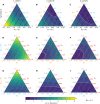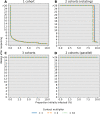An examination of school reopening strategies during the SARS-CoV-2 pandemic
- PMID: 34014947
- PMCID: PMC8136712
- DOI: 10.1371/journal.pone.0251242
An examination of school reopening strategies during the SARS-CoV-2 pandemic
Abstract
The SARS-CoV-2 pandemic led to closure of nearly all K-12 schools in the United States of America in March 2020. Although reopening K-12 schools for in-person schooling is desirable for many reasons, officials understand that risk reduction strategies and detection of cases are imperative in creating a safe return to school. Furthermore, consequences of reclosing recently opened schools are substantial and impact teachers, parents, and ultimately educational experiences in children. To address competing interests in meeting educational needs with public safety, we compare the impact of physical separation through school cohorts on SARS-CoV-2 infections against policies acting at the level of individual contacts within classrooms. Using an age-stratified Susceptible-Exposed-Infected-Removed model, we explore influences of reduced class density, transmission mitigation, and viral detection on cumulative prevalence. We consider several scenarios over a 6-month period including (1) multiple rotating cohorts in which students cycle through in-person instruction on a weekly basis, (2) parallel cohorts with in-person and remote learning tracks, (3) the impact of a hypothetical testing program with ideal and imperfect detection, and (4) varying levels of aggregate transmission reduction. Our mathematical model predicts that reducing the number of contacts through cohorts produces a larger effect than diminishing transmission rates per contact. Specifically, the latter approach requires dramatic reduction in transmission rates in order to achieve a comparable effect in minimizing infections over time. Further, our model indicates that surveillance programs using less sensitive tests may be adequate in monitoring infections within a school community by both keeping infections low and allowing for a longer period of instruction. Lastly, we underscore the importance of factoring infection prevalence in deciding when a local outbreak of infection is serious enough to require reverting to remote learning.
Conflict of interest statement
The authors have declared that no competing interests exist.
Figures






Update of
-
An examination of school reopening strategies during the SARS-CoV-2 pandemic.medRxiv [Preprint]. 2021 Mar 19:2020.08.05.20169086. doi: 10.1101/2020.08.05.20169086. medRxiv. 2021. Update in: PLoS One. 2021 May 20;16(5):e0251242. doi: 10.1371/journal.pone.0251242. PMID: 32793918 Free PMC article. Updated. Preprint.
References
-
- Kuhfeld M, Tarasawa B. The COVID-19 slide: What summer learning loss can tell us about the potential impact of school closures on student academic achievement. NWEA. 2020.
-
- Kuhfeld M, Soland J, Tarasawa B, Johnson A, Ruzek E, Liu J. Projecting the Potential Impact of COVID-19 School Closures on Academic Achievement. Educational Researcher. 2020. November 1;49(8):549–65. 10.3102/0013189X20965918 - DOI
-
- Office of Governor Gavin Newsom. Governor Gavin Newsom Lays Out Pandemic Plan for Learning and Safe Schools. California Governor. Published July 17, 2020. Accessed July 21, 2020. https://www.gov.ca.gov/2020/07/17/governor-gavin-newsom-lays-out-pandemi...
Publication types
MeSH terms
Grants and funding
LinkOut - more resources
Full Text Sources
Other Literature Sources
Medical
Miscellaneous

